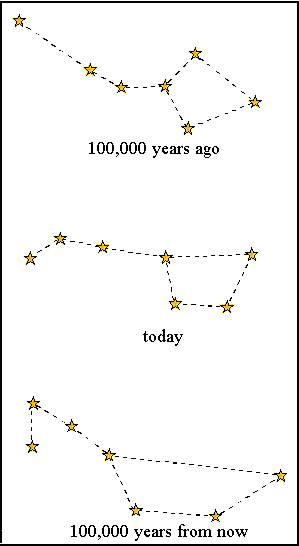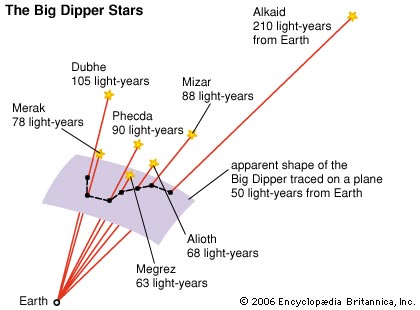Here is how it was imagined the stars for Ursa Major formed this large beast:

Taking away the bear's outline, we are left with the stars, and the imaginary connections we make between them...

Can you see the 'saucepan' shape?
This section (the bear's backside and tail) is brighter and clearer in the sky, and it is one of the easiest to find in the sky. This is the part of the whole constellation we call the Plough:

There are seven main stars of the Saucepan or the Plough. If you learn their names, everyone will think you're very star-smart! Here they are:

One of the great things about this constellation is that it can be found quite easily.
If you stand with your left arm facing where the sun set, you're pretty much facing north, which is roughly where you'll find the Plough. This constellation goes round the North Star (also called Polaris, which isn't as bright as you'd like it to be, but just happens to be pretty much over the North Pole)
Two of the Plough's stars - Dubhe and Merak - have been used throughout history to point to Polaris, and therefore north, by tracing a line directly through them. Strangely enough, they are called 'the Pointers' :-)

The Alaskan flag shows how important this constellation is to the people of Alaska:

And here's the star map to show how Dubhe and Merak point to the North Star (if you look closely, you might see that the North Star - Polaris - is the end of another saucepan shaped constellation. This is Ursa Minor (or the Little Bear), which we'll look at another time).

Another interesting star of the Plough is the second star of the handle, named Mizar in the above images:

Though to the untrained eye this is one star, it is actually a pair of unrelated stars close together in the sky (an optical double).
The brightest of the two is called Mizar, and the slightly 'smaller', or less bright, is called Alcor. Being able to see the seperation of the two stars is sometimes used as a test for good eyesight, since you can just see both stars if you look really carefully with the naked eye. Another name for this pair is the 'Horse and the Rider'.
What might not be so obvious, though, is that Mizar itself is actually a proper binary star - two stars that are gravitationaly bound to each other (in the same way the Moon is bound to Earth)- Mizar A and Mizar B (this next picture shows the ringed area in the image above):

Further interest in this constellation (from Wikipedia)
- Several bright galaxies are found in Ursa Major, including the pair Messier 81 (one of the brightest galaxies in the sky) and Messier 82 above the bear's head, and Pinwheel Galaxy (M101), a beautiful spiral northwest of η Ursae Majoris.
- The other notable spiral galaxies Messier 108 and Messier 109 may also be found in this other constellation.
- Altogether, the constellation contains about 50 galaxies observable through an amateur telescope.
- The bright planetary nebula Owl Nebula (M97), named for its appearance, can be found along the bottom of the bowl of the Big Dipper.
- Of note as a curiosity more than an interesting deep sky object is Messier 40, a double star that Messier nonetheless included in his catalogue
So you can see where all these objects are, here's the picture I showed earlier, with the position of some of the deep space objects in Ursa Major (click on the picture to see it clearer):

And, just in case you're interested in how far away each of those seven main stars are (click on the picture to see it clearer) :

(Remember, a light year (ly) is a distance! It is how far light can travel in one year. So, these stars are a long, long way away, even the closest of them...)
Edit: I came across this image on EarthSky, I really like:
and the same page also describes how the Big Dipper would change over time (worth taking a look):
 |
| (image: EarthSky) |
Next Constellation: Cassiopeia



1 comment:
I want to thank you for providing such a fascinating and educational site about the constellations. I especially love how you include the deep sky objects found in each constellation. It makes stargazing that much more wondrous and magical! I know that you haven't posted in some time, but I just want you to know that your extensive research is/was appreciated. A million thanks!!!
Post a Comment